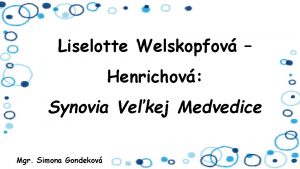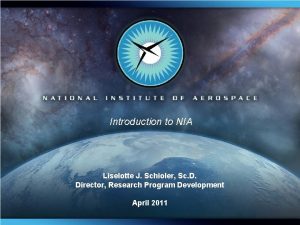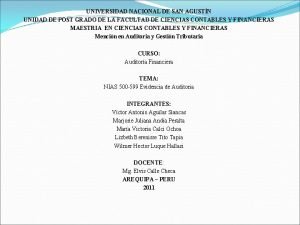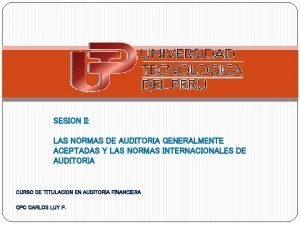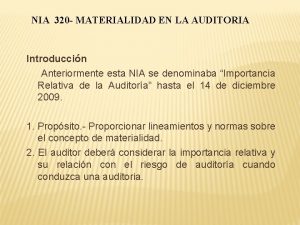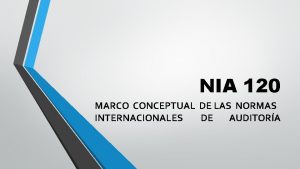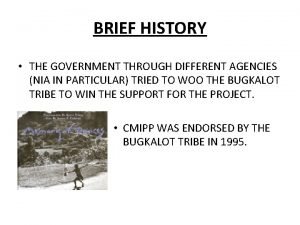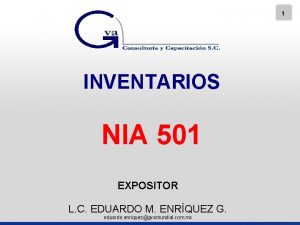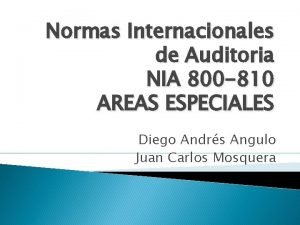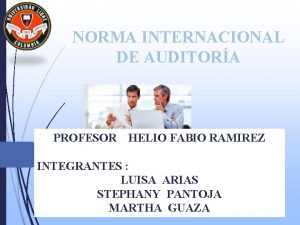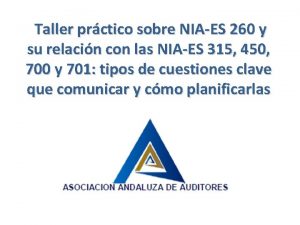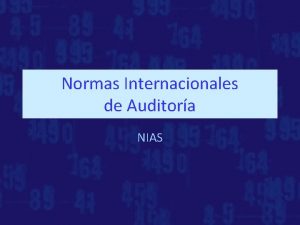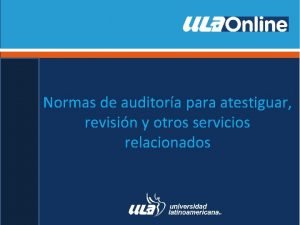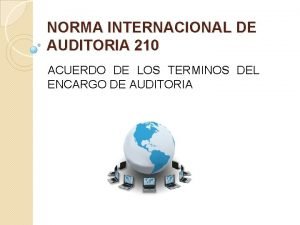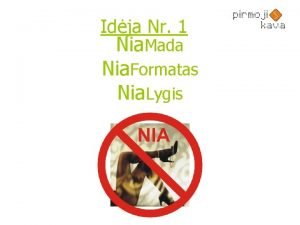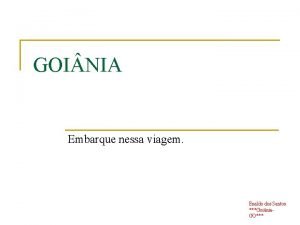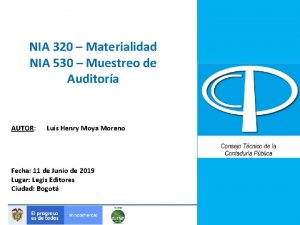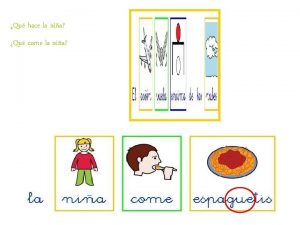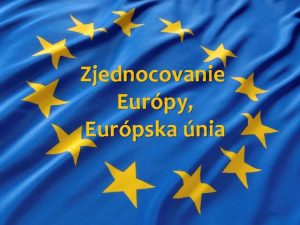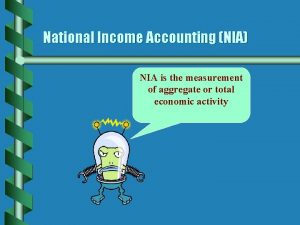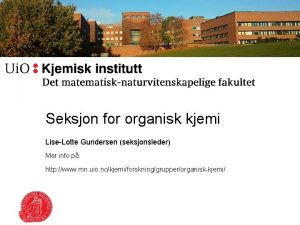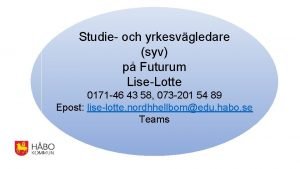Introduction to NIA Liselotte J Schioler Sc D





















- Slides: 21

Introduction to NIA Liselotte J. Schioler, Sc. D. Director, Research Program Development April 2011

National Institute of Aerospace • An Independent Non-profit Research and Graduate Education Institute formed in 2002 by a Consortium of Six Universities and the AIAA Foundation • Conceived by NASA Langley Research Center and established to serve as La. RC’s Collaborative Partner • Conducts Collaborative Research in Engineering and Science relevant to Aerospace • Offers Full- and Part-time Resident Graduate Education in Engineering and the Sciences from Member Universities • Leads and Participates in a wide range of Outreach Programs to enhance the nation’s Science and Technology Workforce

Member Universities Georgia Tech Hampton University North Carolina A&T State University North Carolina State University of Maryland University of Virginia Tech The College of William & Mary Old Dominion University

Organizational Structure Board of Directors Dr. Robert Lindberg President & Executive Director Harla Sherwood Technical Advisory Committee Principal Liaison with Universities Strategic Planning Collaboration Implementation Director, Communications and Partnerships Dr. Calvin Lowe Dr. Bernard Grossman Dr. Karl Drews Kerry Christian Vice President Research & Program Development Vice President Education & Outreach Vice President Operations Chief Financial Officer Research Programs Program/Project Mgmt Business Development Langley Professors Technology Transfer Graduate Education Classroom Operations Continuing Education Curriculum Development Post Doc Program Teacher Prof. Development Public Outreach Contracts/Subcontracts Human Resources IT Facilities Security and Safety Budgeting General Ledger AP/AR Financial Reporting Cost/Pricing Payroll Program Control

Faculty-led Collaborative Research Centers Center for Planetary Atmospheric and Flight Sciences • Director: Prof. Bob Tolson, North Carolina State University Center for Aerospace Acoustics • Director: Prof. Chris Fuller, Virginia Tech Center for Adaptive Aerospace Vehicle Technology • Director: Prof. James Hubbard, University of Maryland Center of Nanotechnology for Advanced Sensors, Actuators and Microsystems • Director: Prof. Mool Gupta, University of Virginia Center for Aerospace Systems Analysis • Director: Prof. Alan Wilhite, Georgia Tech Center for Exploration and Microsatellite Technology • Director: Prof. William Edmonson, North Carolina A&T State University Center for Planetary Dynamics • Director: Prof. Bill Moore, Hampton University

Structures, Materials, Measurement Sciences Analytical & Computational Methods Materials Synthesis & Processing Durability & Damage Tolerance Nondestructive Evaluation Structural Health Advanced Sensing & Optics Structural Concepts Images courtesy of NASA

Aerodynamics, Hypersonics, Acoustics Aeroelasticity & unsteady aerodynamics Configuration Aerodynamics Computational Aerosciences Aerothermodynamics Flow Physics & Control Hypersonic Airbreathing Propulsion Aeroacoustics Structural Acoustics Images courtesy of NASA

Flight Dynamics, Aviation Safety and Airspace Operations Wake Vortex Modeling and Mitigation Aircraft Flight Dynamics Next Generation Air Traffic Management Entry Vehicle Control and Dynamics Software Certification for Avionics systems Launch Vehicle Flight Dynamics Images courtesy of NASA

Planetary Exploration, Atmospheric Sciences and Global Environmental Change Remote Sensing Systems Exploration Systems Analysis Planetary Atmospheric Modeling Clouds and Aerosols Atmospheric Modeling Planetary Atmospheric Flight Images courtesy of NASA

NASA Langley has encouraged NIA to develop research support from other federal agencies Nearly 35% of NIA’s research, education and outreach programs are supported by other customers including NASA Headquarters, other NASA centers, other government agencies, industry and other educational institutions

Outreach at NIA Public Outreach Radio Supported by AIAA NASA-Funded Educational Television Teacher Professional Development Initiatives

NASA Technology Roadmaps Study 12

NASA Technology Roadmaps NRC Study Organization • Study Chair: Dr. Raymond Colladay • NRC Study Director: Mr. Alan Angleman • Steering Committee • Panels • Panel 1: Propulsion & Power • Panel 2: Robotics, Communications & Navigation • Panel 3: Instruments & Computer • Panel 4: Human Health & Surface Exploration • Panel 5: Materials • Panel 6: Entry, Descent & Landing • NRC and Aerospace staff 13

STEERING COMMITTEE MEMBERS (1 of 2) DR. RAYMOND S. COLLADAY, CHAIR, RC Space Enterprises, Inc. DR. IVETT A. LEYVA (P 1) Air Force Research Laboratory DR. PHILIP D. HATTIS (P 2) Draper Laboratory DR. GERALD SCHUBERT (NAS) (P 3) University of California, Los Angeles DR. TAMARA E. JERNIGAN (P 4) Lawrence Livermore National Laboratory DR. LISELOTTE “LISE” J. SCHIOLER (P 5) National Institute of Aerospace DR. JOHN D. ANDERSON, JR. (NAE) (P 6) National Air and Space Museum (Pn) = Steering Committee Liaison to Panel n 14

STEERING COMMITTEE MEMBERS (2 of 2) MAJ GEN JAMES B. ARMOR, ATK, Spacecraft System & Services DR. EDWARD F. CRAWLEY (NAE), Massachusetts Institute of Technology DR. RAVI B. DEO, Northrop Grumman Corporation (Ret. ) MR. WALT FAULCONER, Strategic Space Solutions, LLC. MR. JOHN C. KARAS, Lockheed Martin Space Systems Co. DR. JOHN M. KLINEBERG, Space Systems/Loral (Ret. ) GEN LESTER L. LYLES, The Lyles Group DR. H. JAY MELOSH (NAS) Purdue University DR. DANIEL R. MULVILLE, Mulville Consulting Services DR. DAVA J. NEWMAN, Massachusetts Institute of Technology MAJ GEN RICHARD R. PAUL, (Ret. ) Consultant 15

STATEMENT OF TASK FOR THE NRC • Establish a set of criteria to prioritize technologies • Conduct workshops for each roadmap to solicit public input • Prepare a brief interim report that addresses high-level issues • Panels meet individually to prioritize technologies and suggest improvements to the roadmaps • Prepare a comprehensive final report that • Summarizes findings and recommendations for each of the 14 roadmaps • Integrates outputs from the workshops and panels to identify common threads and issues • Prioritizes, by group, the highest priority technologies from all 14 roadmaps 16

9/24/2010 10/25/2010 1/10/2011 1/25/2011 3/9/2011 5/11/2011 5/14/2011 5/18/2011 6/28/2011 8/1/2011 8/9/2011 8/15/2011 8/27/2011 8/29/2011 9/20/2011 11/5/2011 1/24/2011 Schedule Contract start date New study approach and Statement of Task agreed upon 6 panels and steering committee appointed 1 ST Meeting for Steering Committee and Panels (4 days) Workshops begin Workshops end 2 nd Panel Meetings (3 days) (date approximate) 2 nd Committee Meeting (3 days) (Draft interim report) Interim report to review 3 rd Panel Meetings (3 days) Panel reports due to Steering committee 3 rd Committee Meeting (3 days) Steering committee sends questions to the panels Interim report to NASA Panels respond to questions from the steering comm. 4 th Committee Meeting (3 days) Final Report to review Final Report to NASA 17

Panel Tasks Provide improvements to the NASA roadmap by: • Identify technology gaps • Identify technologies not covered in roadmap • Suggest changes to the development and schedule of technologies in each roadmap • Provide a sense of value of the technologies (e. g. , new science, reduced mass, new missions) • Comment on the risk or reasonableness of the technologies • Prioritize technologies in each roadmap • Prepare written summary of the above 18

EVALUATION CRITERIA • Benefits- enhancements, game changing • Alignment with goals and objectives-NASA, industry, nation • Technical risk and level of difficulty-Risk, timing, effort • Descriptive factors: • Goals and Objectives • Technology Readiness Level • Tipping point • Alignment with NASA’s expertise, capabilities, facilities and the nature of NASA’s role in development of this technology • Would development of this technology substantially benefit from access to the space station? 19

Questions for subject experts • What are the top technical challenges? • Provide technology gaps that the roadmap did not cover. • Identify high priority technology areas for NASA. • Alignment with the NASA’s expertise, capabilities, facilities and role? • NASA’s proposed technology develop. effort & competitive position. • Specific technology as a “Game Changing Technology”? • Any technology component near the tipping point (such that a relatively small additional effort could produce a large advance in technology readiness)? • Time horizon for technology to be ready for insertion (5 -30 year)? • Provide a sense of value in terms of payoffs, risk, technical barriers and chance of success. ØThe roadmaps are primarily focused on TRL 1 -6 technologies. 20

• Draft NASA Roadmaps available at: http: //www. nasa. gov/offices/oct/home/roadmaps/index. html • More details on the study available at: http: //nationalacademies. org/NASAroadmaps OR http: //sites. nationalacademies. org/DEPS/ASEB/DEPS_059552 • Submit comments on the roadmaps at: http: //www 8. nationalacademies. org/asebsurvey/tabs/ • View comments submitted by others at: http: //www 8. nationalacademies. org/asebsurvey/tabs/publicview. aspx 21
 Synovia veľkej medvedice rozbor
Synovia veľkej medvedice rozbor Melisande pulver
Melisande pulver Leescirkel
Leescirkel Hongyu atk
Hongyu atk Nia 580
Nia 580 Nia 930
Nia 930 Nia 320 ejemplos
Nia 320 ejemplos Nia 120
Nia 120 Karolcia filomena
Karolcia filomena Nia history
Nia history Nia 501
Nia 501 Juan andres angulo
Juan andres angulo Objetivo de la nia 505
Objetivo de la nia 505 Nia 701
Nia 701 Si9a
Si9a Nia seating
Nia seating Nia magoulianiti-mcgregor
Nia magoulianiti-mcgregor Nia adrd payline
Nia adrd payline Nia 570 negocio en marcha
Nia 570 negocio en marcha Nia 800-899 areas especializadas
Nia 800-899 areas especializadas Norma 210
Norma 210 Nia in spanish
Nia in spanish
